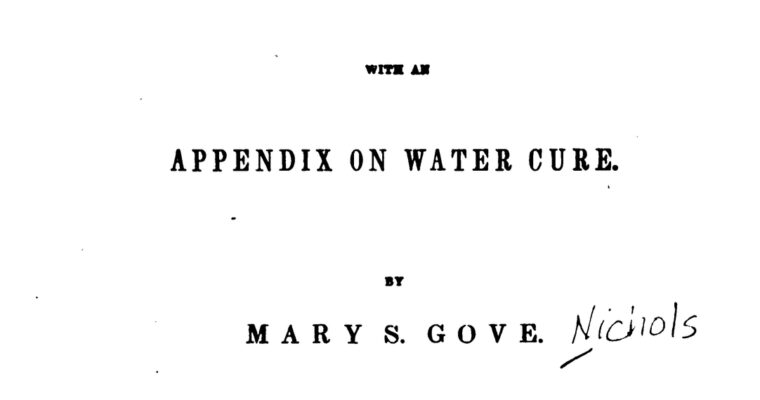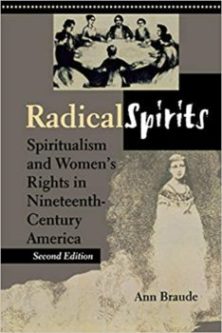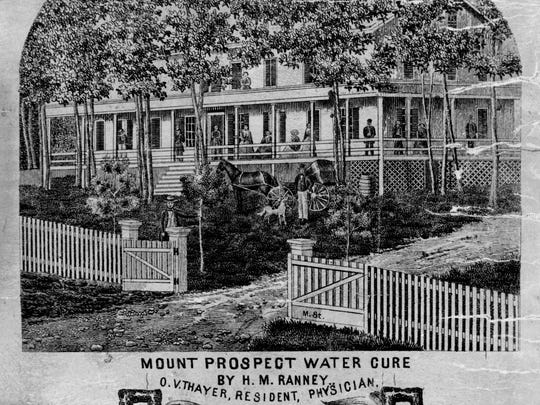Tag: 19th-Century Social Change
Book Review: Radical Spirits by Anne Braude
Ann Braude. Radical Spirits: Spiritualism and Women’s Rights in Nineteenth-Century America. Bloomington: Indiana University Press, 1989, 2001. Anne Braude’s 1989 Religious Studies classic Radical Spirits was one of the first texts to discuss how religion empowered women politically through the late nineteenth-century phenomenon of Spiritualism, a …
Hypnosis & Self-Help: A Lineage (or, another book summary/review)
Robert C. Fuller. Mesmerism and the American Cure of Souls. Philadelphia: University of Pennsylvania Press, 1982.
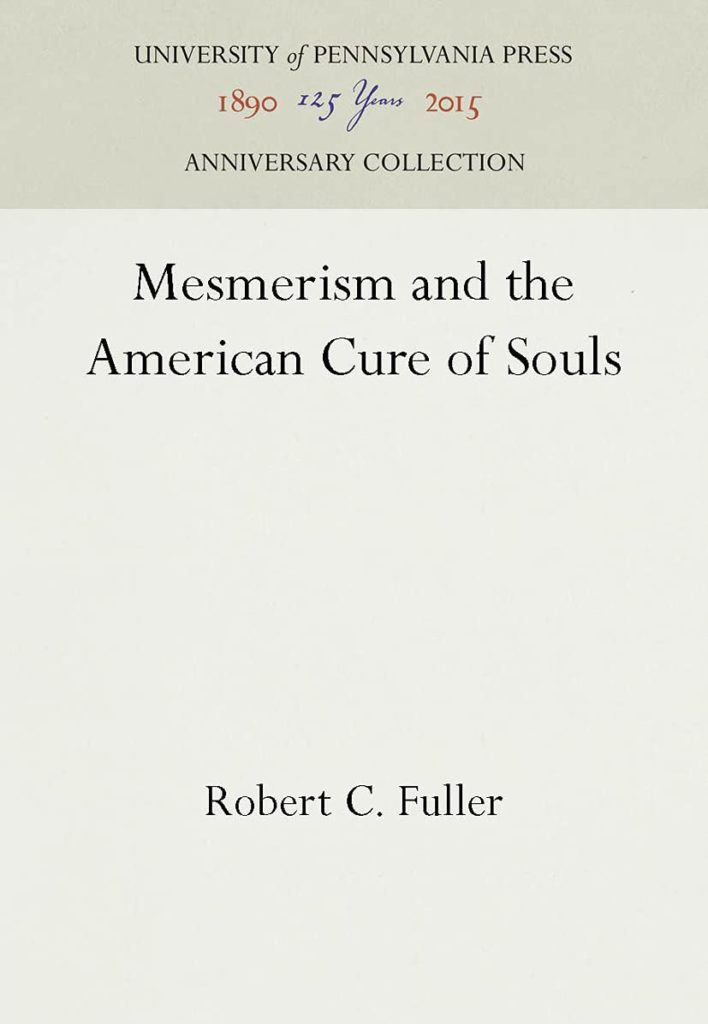
Robert Fuller writes a history of 19th-century mental healing traditions that connects European Mesmerism to the development of distinctly American religious-psychological traditions such as Christian Science and New Thought.
Fuller positions Mesmer’s healing practice in the Enlightenment rationality of its time. His contemporary and rival, the Swiss priest Johann Gassner, healed through a traditional method, the Cure of Souls—exorcism. Fuller finds the two rituals very like one another, with Mesmer’s based on the science and rationality of the day. As such, it became popular among the “idle elites” in the 1770s.
Mesmer’s new scientific healing ritual replaced the religious tradition for a time. He claimed that there was only one illness and only one healing, a grand claim not unlike those of Catholicism, directed toward human ailments from a sore throat to depression. Because, Fuller argues, Europe had institutions in place that “ordered personal and social life” (or perhaps controlled them), Mesmerism died out once it was debunked, though his pupil Puységur would develop methods of working with the subconscious mind, which developed into hypnotism and exploration of the subconscious and unconscious (see Jean-Martin Charcot and Pierre Janet), ultimately developing into modern psychology and psychiatry.
It was Puységur’s method (still called mesmerism) that entered the United States through the work of his student Charles Poyen, who lectured on mesmerism in the Northeast (see Ogden), putting his subjects in trances and promising remarkable healing. This, as we have learned from Cayleff, Reynolds, Braude, and Modern, was an era of spectacular searching and reform in the young United States (though Fuller does not discuss the social reforms of the era).
Poyen landed in the United States at the time of the second great evangelical revivals, where spiritual searching met communitarian ideas and extensive social reform. Most scholars have more recently agreed that Protestants (who dominated the U.S. scene) reconciled their religion with science, rather than abandoned it. Fuller is the old guard, who argued that this mesmerism allowed Americans to abandon religion for a new psychology—or to hold both in tandem, as a slow shift toward a godless religion of self help gradually emerged by the 20th century. Out of subliminal trance came theories of psychology that met the intellectual and spiritual needs of seeking Americans.
It was, of course, a time of chaotic change (isn’t it always?), and the zeitgeist was heavily individualistic and anti-authoritarian. The evangelical thrust moved away from orthodox doctrines of the Puritans, Presbyterians, and Congregationalist toward more emotive expositions of Christianity. Religious rituals gave way in some circles to the mind rituals of mesmeric trance and healing, and with it, a new psychological approach to understanding health and life. Fuller suggests that the carnival atmosphere of 1840s America led to a mesmerism that “straddled a fine line between religious myth and scientific psychology…. Mesmerism’s explanation of human health and happiness held that personal wholeness was not reducible to mechanistic analysis but rather entered into the finite personality from some transpersonal source” (68). The individual could be in harmony with a divine, vital force if they were willing and able to open themselves to it. This created a space for Americans to eventually move from religious to secular.
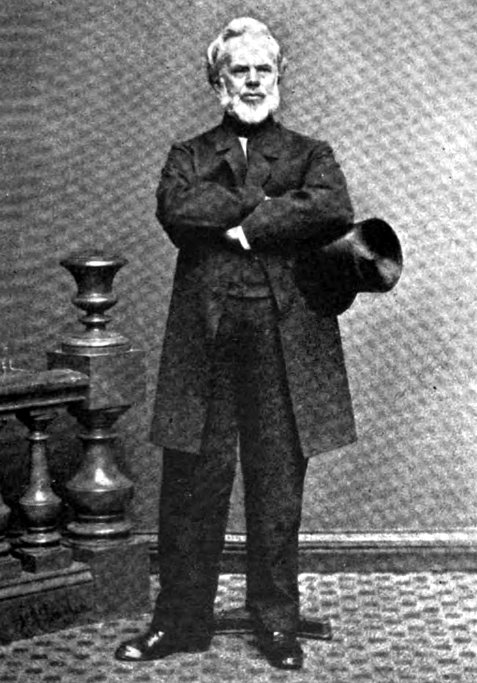
A key figure in that move was Phineas Parkhurst Quimby, who took up mesmerism in the early 1840s. By the 1850s, progressive Christians such as the Swedenborgians, Universalists, and spiritualists found that mesmerism allowed an evidence-based connection with god which offered an individualistic seeking. By the 1860s, Mary Baker Eddy was following Quimby, now an established healer, hypnotist and teacher of the power of mind. Eddy later founded Christian Science.
Fuller argues that Quimby’s teachings were superficial and self-serving. Though Christian Science and New Thought developed from them, which scholars such as Braden and Satter argue had socialist and communitarian leanings early on, Fuller sees only the development of a self-help spirituality that turned into catchy aphorism marketed to self-help seekers who, self-absorbed and narcissistic, could not manage healthy social relationships and community. Instead, they leaned on a positive sound-byte philosophy which allowed them to manage uncertainty and never-ending change in the modern world.
Fuller preaches that without religion, there is no ethical anchor that teaches us to mind our communities as well as ourselves. He connects these 19th century movements to spiritual movements of the 1970s such as EST and transcendental meditation. Though he does point out the introspection of Quimby, he believes it devolved with the mind cure into finding one’s “true self” (150).
Fuller is a religion scholar but offers a history of a 19th-century American slide from religion to secular psychology. New Thought, however, was never entirely secular, and there are far more expansive histories than this, which we’ll cover in the next few weeks.
CATEGORIES: Mesmerism, Hypnosis, Mind Cure, New Thought, 19th-Century U.S. History, Cultural History, Religious Studies, 19th-Century Social Change, Spirituality, Psychology, Psychiatry, Religious Life & Customs
PLACE: United States
TIME PERIOD: 1775-1890 (focus on 1836-1890)
If you’d like to support the site, buy stuff that you need from the links. Some of them send us kickbacks at no cost to you, but a wee cost to the empire.
Thank you! ♥
Cold Water Bathing in 19th-Century American Health Care
Another! And finally we are moving into health books. Susan E. Cayleff. Wash and Be Healed: The Water-Cure Movement and Women’s Health. Philadelphia: Temple University Press, 1987. Washed and Be Healed is a fantastic look at the history of women’s experiences of the mid-nineteenth century …
Book Review: Credulity: A Cultural History of US Mesmerism by Emily Ogden
Like last time, because it’s relevant to this Gymnosophist project, I’m sharing a review I wrote that relates to our lineage here (or one of them)—a piece of the history of spirituality in the U.S., this time from a scholar of English. It is something …
Book Review: Secularism in Antebellum America by John Modern
Hello, everyone. I abandoned you to my books and teaching for awhile, and for that apologies. I’m studying for exams and it’s just been impossible to post regularly even about fun stuff because frankly, I cannot bear to look at a screen any more than I must. I do promise I’ll get back to the masculine/feminine thing soon enough.
Because it’s relevant to this Gymnosophist project, I’m sharing a review I wrote that relates to our lineage here (or one of them)—a piece of the history of spirituality in the U.S. It’s heavily post-modern so it won’t be for everyone, but I do recommend the book. Modern has a new one out, too: Neuromatic: Or, A Particular History of Religion and the Brain, University of Chicago Press, 2021. I have not read this yet, but it looks good. Enjoy!
John Lardas Modern, Secularism in Antebellum America: With Reference to Ghosts, Protestant Subcultures, Machines, and Their Metaphors; Featuring Discussions of Mass Media, Moby-Dick, Spirituality, Phrenology, Anthropology, Sing Sing State Penitentiary, and Sex with the New Motive Power. Chicago: University of Chicago Press, 2011.
PLACE: United States
TIME PERIOD: 1840s
SUMMARY:
When the Honorable Judge Edmonds felt a repeated, warm pulsing touch on his upper left thigh, he felt that something had an overwhelming desire to communicate with him. He consulted a spirit medium, who gently passed on reassuring personal messages from the dead. This “touch of secularism” arose from Edmonds’ involvement with evangelical reform in the women’s ward at Sing Sing State Penitentiary in the 1840s. A haunted, technicolor tale, it is typical of Religious Studies scholar John Lardas Modern’s Secularism in Antebellum America. Modern challenges the prevailing historiography of religion, secularism and agency in nineteenth-century antebellum America. Secularism, in his eyes, was not a conscious disenchantment via Enlightenment reason and science but was instead deeply entangled with the enchanted world and included its own metaphysics.[1]
Modern posits that secularism in the U.S. emerged within the evangelical Protestant tradition when the move away from sectarian, authority-oriented evangelical piety toward personal, reasoned, science-embracing and individually-governed Christian belief was transmitted through various new “technics” (e.g. machines and media such as religious pamphlets) embedded in the conditionality of a modernizing America. Modern questions Mark Noll’s celebration of religious agency and individuality in this period and suggests instead that personal agency is tricky and questionable.[2]
This analysis engages the theoretical maneuverings of Foucault: “Agency is not an either/or prospect. It is circuitous. It happens, but always in and through ‘instruments, techniques, procedures, levels of application, targets, and concepts.” Instead of the conscious self-realization of a disenchanted “True Religion,” Americans instead made choices from a dizzying new array of options, not in essence, but through “a mood or sensibility in and through which choices are made and made to feel decisive.” (Were they, though, made to feel decisive? Or is that just a nice touch?) In other words, they were socially conditioned, and agency was and is “an open question” (7, 16-17). Modern’s rhetoric is sometimes spirited and sometimes unnecessarily dense. It is bold and impressive. Fonder of ideas than historical materiality, his argument imbibes the same fantastic and circular feel that he claims was characteristic of religion in antebellum America.
Modern first interrogates the media practices that increased in popularity in the nineteenth century. These strove for a “systematic common good” through tracts published by the American Bible Society (one of the many New York institutions recently lost to lux real estate) and the American Tract Society, both institutions initiated by Lyman Beecher (recall Reynolds). This system was not one of direct control through the local church but though a calculated, rational education of “individuals” each reading in their homes. These evangelicals sought to create an imagined public whose individual moral concern and well-being was at the heart of the imagined good. Modern highlights evangelical media practices’ effects on “conceptions of the self and the social” (51). These media practices ordered both “true religion” and “expectations of mundane life,” and he analyzes how this impacted the individual and her relationship to the commons, piety, politics, and epistemology.
Secularism here was not without god. In fact, it was ordered by a reasoned, epistemic belief in Protestantism as a moral force for good inflected with Scottish Common Sense and American republicanism, both essential to a new American individual, communal, and political life. Here, the religious citizen is no longer an authoritarian Calvinist, but an enlightened, open individual in touch with the true essence of religion and a moral common good who was not necessarily involved in the local church, but was certainly reading evangelical tracts and participating in public life. This evangelicalism was not direct or heavy handed, but a “metaphysical solvent rather than a substantive ideology” which “did not even exist at the level of empirical reality” (55). These widely dispersed evangelical tracts also drew on the republican tropes of liberty and freedom according to and awarded by Christian moral law which allowed Christian individuals an “unmediated” self and connection to God.
Modern finds these themes in Robert Baird’s 1844 tome Religion in the United States. For Baird, evangelicalism was inevitable due to its “natural” advancement of liberty, virtue, and knowledge all while providing a direct, individual relationship to god. He provides the history of a Protestant “evolution” from “religionism” to “true religion” and contradicts Tocqueville’s critique of American religion as unexamined. Baird saw evangelicalism as a thoughtful, republican effort toward liberty and unity defined by the American’s freedom to practice it. To illustrate its secularism, Modern quotes Reverend Barnes, “Christian piety was the index of intellectual advancement” and essential to “modern science.” Piety called “forth the active powers of the mind,” and created, “true independence of thinking and investigation” (recall Howe’s emphasis on a nineteenth-century Protestantism that actively engaged emerging scientific theories). Modern surmises that religion in the United States was written in the spirit, if not the name, of secularism, “a medium through which the ‘gigantic’ synthesis of personal piety and civic order would unfold” (79, 83). Secularism in the U.S. was born within evangelical Protestantism, not against it. To demonstrate its enchantment, Modern turns to “spirituality.”
Protestants of all sects began to use this term more frequently in the early 1800s, usually to address the “immateriality of God.” Modern reports that liberals began to link the term with a human capacity for religion rather than an exclusive providence of the divine, reflected in the increased use of cognates such as “spirit-filled, spiritual religion, spiritual discernment, spiritual activity, spiritual perception.”
Rather than an apolitical project of self, Modern investigates the “complex game of truth” at play. The concepts of spirituality such as reasoned objectivity, transcendental communion, solitary transformation, anti-institutionalism, etc., have political meaning in time and place. What is being transcended? What “forms of self” are being transformed and who is involved in these transformations?
To find the answer, see Emily Ogden’s Credulity.
If you want to know more about Judge Edmonds, read the book.
[1] Disenchantment (“Entzauberung,” literally “de-magication,” a broken spell) was the term used by Max Weber to describe the modern, scientific consciousness he argued would inevitably replace religion and superstition. Because science must explain everything in such a world, a loss of wonder and delight result.
2 Mark A. Noll, America’s God: From Jonathan Edwards to Abraham Lincoln. New York; Oxford: Oxford University Press, 2005.
Was this useful? Keep us going with a quick tip. Thank you! And buy stuff that you need from the links. Some of them send us kickbacks at no cost to you, but a wee cost to the empire. Thank you! ♥
